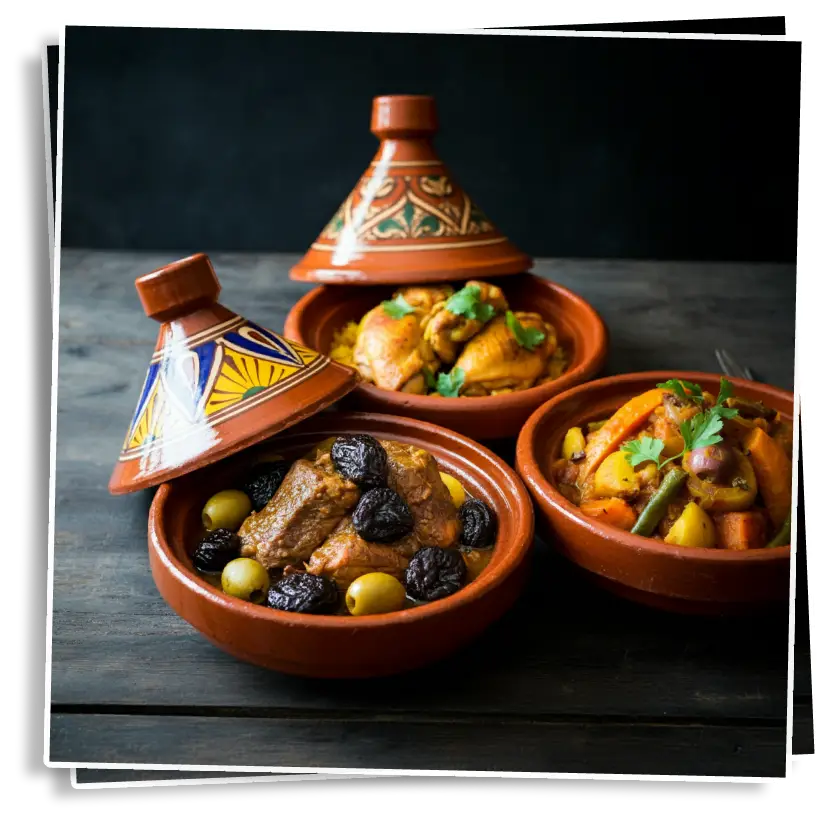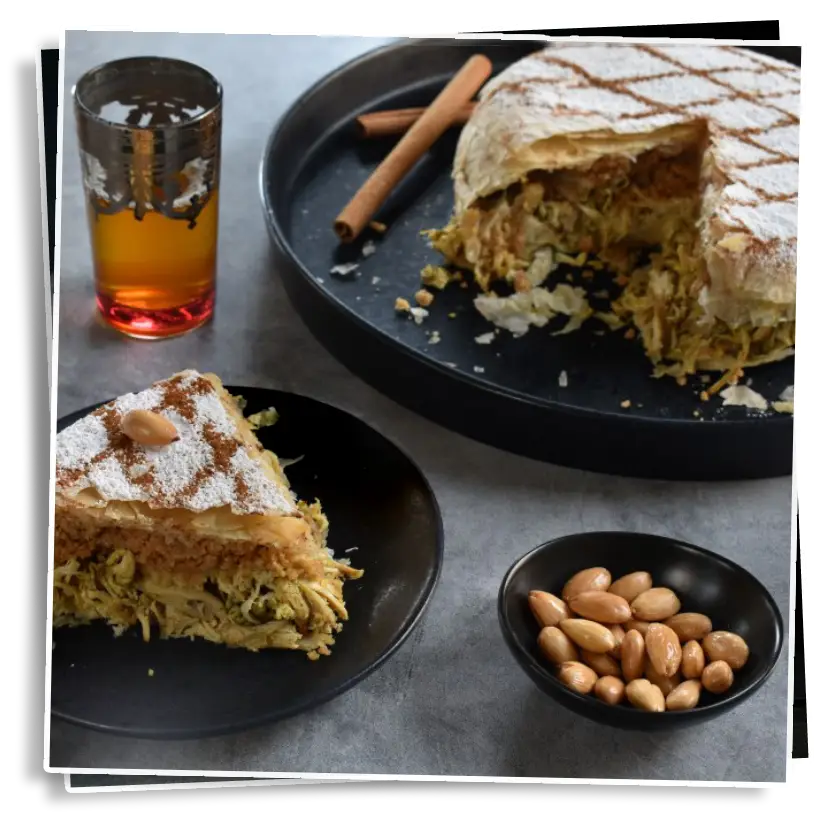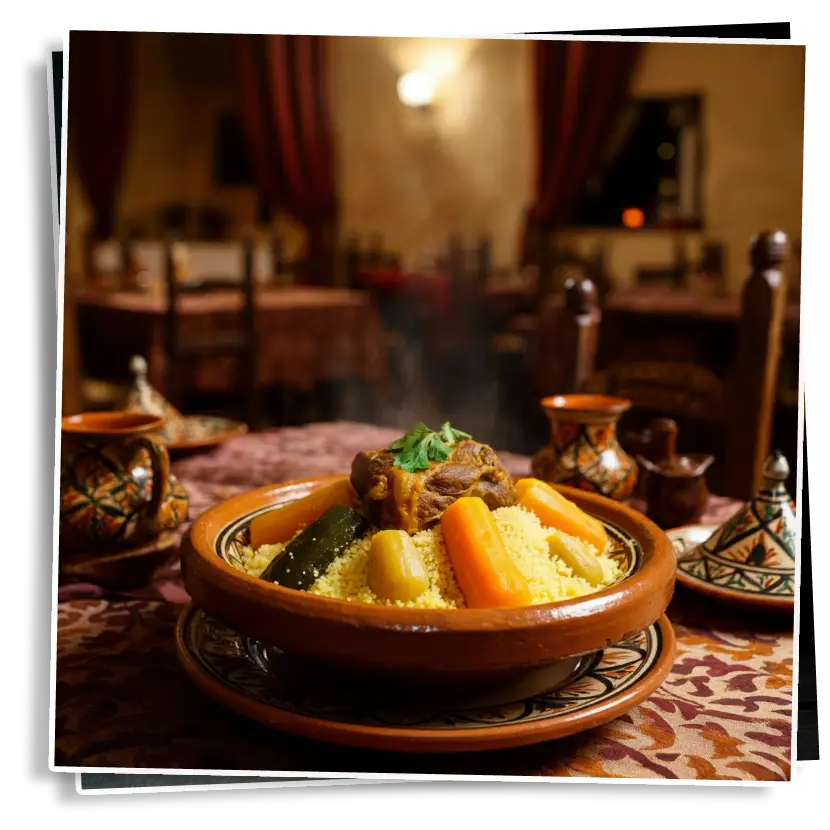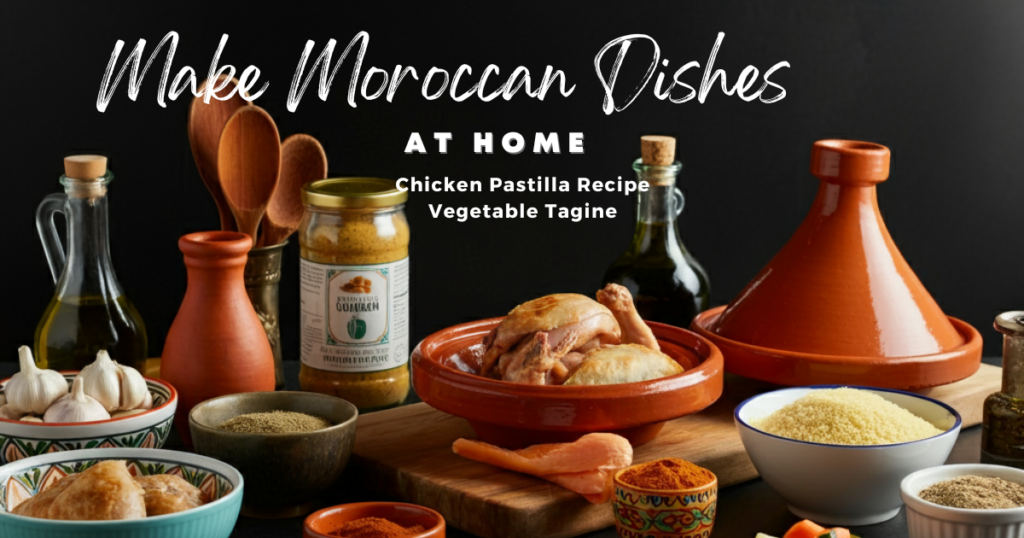The Essential Guide to Moroccan Cuisine: From Tajines to Pastilla and Beyond
Moroccan cuisine is a tapestry of flavors and traditions that have evolved over centuries, shaped by diverse cultural influences. This cuisine uniquely blends ingredients, spices, and culinary techniques from Berber, Arab, Moorish, French, and Spanish cultures, creating dishes that are both distinctive and widely celebrated. Moroccan dishes are not only meals but also cultural expressions that reflect the country’s rich history, landscape, and communal spirit. Each dish, from street food to grand feasts, tells a story of flavor, heritage, and the warmth of Moroccan hospitality.
Moroccan cuisine’s allure lies in its use of bold spices and fresh ingredients. Spices like cumin, coriander, saffron, cinnamon, and ginger are essential and elevate the flavors of even the simplest ingredients. Herbs like mint, parsley, and cilantro, alongside rich olive oil and sweet notes from dried fruits such as apricots and raisins, create harmonious layers of flavor that define Moroccan dishes. These ingredients aren’t only used for taste; they reflect the agricultural bounty of the Mediterranean region and embody the seasonality cherished in Moroccan cooking.
Another defining feature is the communal style of Moroccan dining. Meals are often shared from large dishes, encouraging a sense of unity and warmth. From elaborate wedding feasts to simple family dinners, food is an integral part of Moroccan social life, and every meal is an opportunity to connect and celebrate. This approach to food as a shared experience is particularly evident in Morocco’s signature dishes, like tajine, pastilla, and couscous, each with distinct flavors and significance.
The Art of the Tajine

A quintessential symbol of Moroccan cuisine, the tajine is both a dish and a cooking vessel. Named after the earthenware pot with a conical lid in which it is cooked, the tajine combines flavors and aromas that are as complex as they are comforting. The unique design of the tajine pot helps to create a slow-cooking environment where moisture and flavor are preserved, resulting in tender meats and aromatic sauces.
Traditionally, tajines are cooked over low heat, allowing the ingredients to meld together gradually. This cooking method is well-suited to the Mediterranean climate, where patience and simplicity are central to culinary traditions. Tajine recipes vary widely, with some of the most beloved types including lamb with prunes, chicken with preserved lemons and olives, and vegetable tajine with seasonal produce.
- Lamb with Prunes: Often flavored with cinnamon, honey, and almonds, this dish is a harmonious blend of sweet and savory flavors, resulting in a dish that is both rich and aromatic.
- Chicken with Preserved Lemons and Olives: This is a lighter but equally flavorful tajine that balances the tartness of preserved lemons with the briny taste of olives, creating a delightful contrast.
- Vegetable Tajine: A favorite among vegetarians, this version of the tajine showcases Morocco’s seasonal vegetables, with spices like turmeric and cumin bringing out natural flavors and enhancing the dish’s warmth.
Cooking a tajine at home can be a rewarding experience, and it’s relatively simple with a bit of preparation. Begin by layering meat or vegetables at the bottom of the tajine pot, followed by aromatic herbs, spices, and a small amount of water or broth. As it cooks slowly, the flavors concentrate, resulting in a dish that’s rich and fragrant. Many modern adaptations of the tajine have emerged, making it accessible to a global audience while retaining the essence of Moroccan cooking.
The Allure of Pastilla

Pastilla, also known as bastilla, is a masterpiece of Moroccan cuisine that seamlessly combines sweet and savory elements. Originating in Fez, this delicacy is often served at weddings and special occasions, and its intricate layers and flavor combinations make it one of Morocco’s most iconic dishes. Traditionally, pastilla is made with pigeon, although chicken is a common substitute. The filling is encased in a thin, flaky pastry and layered with a delicate mixture of almonds, spices, and sugar.
The preparation of pastilla is a true art form. First, the meat is slow-cooked with spices, including saffron, ginger, and cinnamon. Once tender, the meat is shredded and mixed with eggs and herbs. A layer of crushed almonds and powdered sugar adds a unique sweetness, creating a contrast to the savory meat. The mixture is then wrapped in layers of thin, phyllo-like dough, brushed with butter, and baked until golden.
Variations of pastilla showcase the versatility of this dish. Seafood pastilla, for example, is made with shrimp, fish, and vermicelli noodles, offering a lighter but equally flavorful alternative. Regardless of the filling, pastilla remains a dish that exemplifies the sophistication of Moroccan cuisine, blending diverse flavors in a way that is both innovative and rooted in tradition.
For those interested in trying to make pastilla at home, patience and attention to detail are key. Start by preparing the filling, ensuring each component is well-seasoned and cooked to the right consistency. Assembling the pastry requires gentle handling, but the result is a beautifully layered pie that’s both crisp and tender.
Couscous: Morocco’s National Dish

Often referred to as the national dish of Morocco, couscous is more than a staple; it’s a cultural emblem. Traditionally made from steamed semolina wheat, couscous is usually prepared on Fridays as part of a communal meal. The process of making couscous by hand, steaming it multiple times to achieve the perfect texture, reflects the Moroccan dedication to culinary artistry.
There are several variations of couscous, often featuring vegetables, chickpeas, and meats such as lamb or chicken. Popular versions include vegetable couscous, lamb couscous with a savory broth, and sweet couscous with raisins and almonds. Each version highlights the versatility of couscous, allowing it to adapt to seasonal ingredients and regional preferences.
Preparing couscous authentically involves a multi-step steaming process, where the semolina grains are steamed above a pot of simmering broth or stew, infusing them with flavor. The grains are fluffed by hand between steaming rounds, resulting in a light, airy texture. Although this process can be time-consuming, it’s an essential step in Moroccan kitchens. When served, couscous is often topped with tender vegetables, meat, and a ladle of broth, creating a complete, balanced meal that embodies the flavors of Moroccan cuisine.
The tradition of sharing couscous underscores its role as a unifying dish. In Moroccan culture, families and friends gather around a communal dish of couscous, each person taking from the same plate, symbolizing harmony and connection.
Exploring Moroccan Chicken, Fish, and Beef Dishes
Moroccan cuisine is renowned for its variety of meat dishes, particularly chicken, fish, and beef, each prepared with unique spices and techniques that reflect the country’s culinary heritage.
- Moroccan Chicken Dishes: Chicken is a staple in Moroccan cooking, often featured in both tajines and grilled dishes. A classic example is the chicken tagine with preserved lemons and olives, where the zesty and salty flavors create a delicious harmony. Other popular chicken dishes include pastilla and chicken skewers marinated in fragrant spices like cumin and paprika, served with fresh vegetables or in a flatbread wrap.
- Moroccan Fish Dishes: Coastal cities such as Essaouira and Agadir boast fresh seafood, making fish dishes a vital part of Moroccan cuisine. One of the standout preparations is grilled sardines, often seasoned with a blend of spices and served with a side of zaalouk, an eggplant and tomato salad. Fish tagine, made with ingredients like tomatoes, olives, and a variety of spices, exemplifies how Moroccan flavors can beautifully enhance seafood.
- Moroccan Beef Dishes: Beef is less commonly used than lamb or chicken but still plays an important role in Moroccan cooking. Dishes like kefta (spiced ground beef meatballs) are popular, often served with a tomato sauce or stuffed into pastries. Beef tagine, which may include vegetables or fruits like prunes, highlights the adaptability of Moroccan beef dishes to incorporate a range of flavors and textures.
Notable spices used in these meat dishes include saffron for chicken, coriander, and paprika for fish, while cumin and cinnamon often flavor beef. These spices not only add depth but also speak to Morocco’s historical trade routes and cultural exchanges, illustrating how flavors evolve through globalization.
Vegetarian and Vegan Moroccan Options
Moroccan cuisine is incredibly accommodating to vegetarian and vegan diets, showcasing a wealth of plant-based dishes that are both hearty and flavorful.
- Vegetable Tajine: A popular vegetarian option, this dish features a colorful array of seasonal vegetables, including carrots, zucchini, potatoes, and chickpeas, seasoned with spices such as cumin and turmeric. The slow cooking method allows the flavors to meld together, resulting in a comforting and nutritious meal.
- Zaalouk: This is a beloved eggplant salad made with roasted eggplant, tomatoes, garlic, and spices. It serves as a great appetizer or side dish and is often enjoyed with bread.
- Chickpea and Lentil Dishes: Moroccan cuisine incorporates legumes prominently, with dishes like harira, a hearty soup made with lentils and chickpeas, often enjoyed during Ramadan. These legumes are not only rich in protein but also provide a satisfying texture and flavor.
- Salads: Fresh salads are common in Moroccan meals, featuring ingredients like tomatoes, cucumbers, and olives, dressed in olive oil and lemon juice. These salads complement richer dishes and provide a refreshing balance.
Moroccan culinary traditions emphasize the use of fresh vegetables and grains, making it easy for vegans to find delicious options. The focus on spices and herbs enhances the flavor profile of plant-based dishes, ensuring that every meal is satisfying and robust.
Moroccan Side Dishes and Accompaniments
No Moroccan meal is complete without an array of side dishes and accompaniments that enhance the dining experience and offer a variety of flavors and textures.
- Harira: This traditional soup, made with tomatoes, lentils, chickpeas, and a blend of spices, is often served as an appetizer during Ramadan but is enjoyed year-round. It is hearty and full of flavor, providing a warm start to any meal.
- Khobz: Moroccan bread, known as khobz, is an essential part of every meal. It is typically round, crusty, and perfect for tearing and sharing. Often served alongside tajines and stews, khobz is used to scoop up food, reflecting the communal nature of Moroccan dining.
- Briouats: These savory pastries are filled with a mixture of meat or cheese and spices, then wrapped in thin dough and baked or fried. They make for an excellent appetizer or snack, showcasing the flaky texture that is a hallmark of Moroccan cooking.
- Mint Tea: Often referred to as Moroccan whiskey, mint tea is a staple beverage that embodies the hospitality of Moroccan culture. The preparation of mint tea is ritualistic, involving the pouring and mixing of green tea, mint leaves, and sugar. It is served at nearly every gathering and is an essential part of Moroccan social life.
These side dishes and accompaniments not only complement the main courses but also add layers of flavor and tradition to the meal. They create a well-rounded dining experience that embodies the rich culinary heritage of Morocco.
How to Make Moroccan Dishes at Home

For those inspired to bring the flavors of Morocco into their own kitchens, making traditional Moroccan dishes at home is both rewarding and accessible. Here are a couple of popular recipes to get you started, along with essential tips for achieving authentic Moroccan flavors.
Chicken Pastilla Recipe
Ingredients:
- 1 whole chicken, cut into pieces
- 2 onions, finely chopped
- 2 tablespoons olive oil
- 1 teaspoon ground ginger
- 1 teaspoon ground cinnamon
- 1 teaspoon saffron threads
- Salt and pepper to taste
- 4 eggs
- 1 cup almonds, toasted and crushed
- 1 package of phyllo pastry
- Powdered sugar and cinnamon for dusting
Instructions:
- In a large pot, heat the olive oil and sauté the onions until translucent. Add the chicken pieces, ginger, cinnamon, saffron, salt, and pepper. Cover with water and simmer until the chicken is tender and cooked through.
- Remove the chicken from the pot and shred the meat, discarding the bones. In the same pot, reduce the cooking liquid to concentrate the flavors.
- Beat the eggs in a bowl and add them to the pot, stirring until cooked. Combine with the shredded chicken and crushed almonds.
- Preheat the oven to 375°F (190°C). Grease a round baking dish and layer sheets of phyllo pastry, brushing each layer with melted butter.
- Add the chicken mixture in the center and fold the edges of the pastry over the filling. Top with more phyllo sheets and brush with butter.
- Bake until golden brown. Dust with powdered sugar and cinnamon before serving.
Vegetable Tagine
Ingredients:
- 2 tablespoons olive oil
- 1 onion, chopped
- 2 cloves garlic, minced
- 1 carrot, diced
- 1 zucchini, diced
- 1 bell pepper, chopped
- 1 can chickpeas, rinsed and drained
- 2 cups vegetable broth
- 1 teaspoon ground cumin
- 1 teaspoon ground coriander
- 1 teaspoon paprika
- Salt and pepper to taste
- Fresh cilantro for garnish
Instructions:
- In a large pot or tagine, heat the olive oil and sauté the onion and garlic until soft. Add the carrots and cook for a few minutes.
- Add the zucchini, bell pepper, and chickpeas. Stir in the spices, salt, and pepper.
- Pour in the vegetable broth, cover, and simmer for about 30 minutes, until the vegetables are tender.
- Garnish with fresh cilantro before serving. Serve with khobz (Moroccan bread) or over couscous.
Tips for Authentic Moroccan Cooking
- Use Quality Spices: Authentic Moroccan cuisine relies heavily on spices. Look for high-quality spices like cumin, coriander, cinnamon, and saffron to enhance your dishes. Consider visiting a local spice market to find fresh, vibrant spices.
- Incorporate Dried Fruits: Many Moroccan dishes feature dried fruits like apricots, prunes, and raisins. These ingredients add a sweet contrast to savory dishes and are a hallmark of Moroccan cooking.
- Practice Slow Cooking: Many Moroccan recipes benefit from slow cooking to develop flavors. If possible, use a tagine or a heavy pot to simmer dishes for a longer period.
Frequently Asked Questions (FAQ) about Moroccan Cuisine
What is Morocco’s national dish?
The national dish of Morocco is often considered to be couscous. Traditionally served on Fridays, it symbolizes community and is enjoyed with a variety of meats and vegetables.
What makes Moroccan pastilla unique?
Pastilla, or bastilla, is unique for its combination of sweet and savory flavors. It is typically made with pigeon or chicken, layered with spices, almonds, and a flaky pastry shell, creating a dish that is both rich and delicate.
Is pastilla a Puerto Rican food?
No, pastilla is a traditional Moroccan dish. While Puerto Rican cuisine has its own unique dishes, pastilla is specifically associated with Moroccan culinary traditions.
Can you substitute ingredients in Moroccan dishes?
Yes, you can often substitute ingredients in Moroccan dishes based on availability or dietary preferences. For instance, chicken can be swapped for turkey or other meats in tagines, and various vegetables can be used in place of those suggested in recipes.
What are traditional Moroccan flavors and seasonings?
Traditional Moroccan flavors often include spices such as cumin, coriander, cinnamon, saffron, and paprika. Fresh herbs like parsley and cilantro are also commonly used. These ingredients contribute to the complex and aromatic profile of Moroccan cuisine.
Conclusion: Why Moroccan Cuisine is a Must-Try
Moroccan cuisine offers a rich tapestry of flavors, colors, and aromas that invite exploration. Whether dining at a restaurant or preparing dishes at home, the experience of Moroccan food is one that delights the senses and fosters connection.
Each dish tells a story, reflecting the diverse influences and traditions that shape Moroccan culture. From the comforting tajine and the exquisite pastilla to the iconic couscous, Moroccan cuisine encapsulates the warmth of hospitality and the joy of communal dining.
As you embark on your culinary journey into Moroccan cuisine, allow the vibrant spices and fresh ingredients to inspire your cooking. Embrace the opportunity to share these delicious meals with family and friends, creating memorable experiences that celebrate the rich heritage of Morocco. Whether you are a seasoned chef or a curious beginner, Moroccan food is a journey worth taking, promising satisfaction and delight with every bite.
